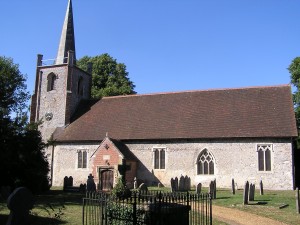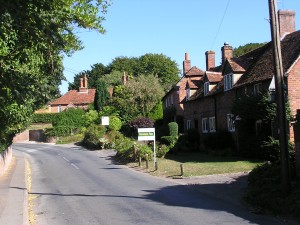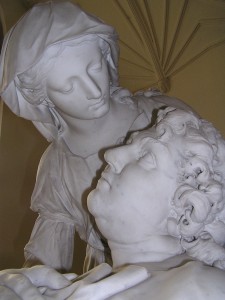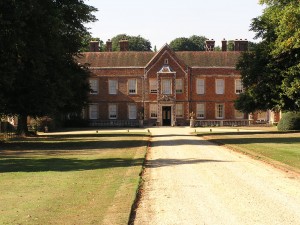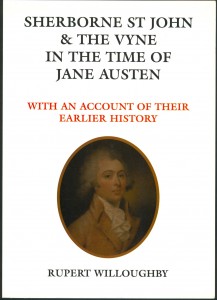There was great consternation in St James’s, Bramley, last winter, when the boiler failed, and doughty congregants were left perishing in the pews. However warm the welcome, church-going became a distinctly uncomfortable experience!
To generations of our ancestors, however, central heating would have seemed an unimaginable luxury. Until the nineteenth century, in the absence of all the comforts and conveniences that we now take for granted, attendance at a country church was almost invariably a penance, if not an ordeal.
Vivid descriptions of Sherborne St John, the neighbouring parish, remind us of the sheer discomfort and, frankly, the squalor of our relatively recent past. In 1827, the lordship of the manor was inherited by Wiggett Chute. The estate had been mismanaged for a century and was, in Wiggett’s view, a blot on the landscape. A typical Victorian reformer, he had a keen sense of responsibility towards his tenants and was determined to sweep away the unwholesome relics of the past. He was to do so very successfully, and was the architect – literally – of the prosperous community of today.
The Sherborne of two hundred years ago was an agricultural settlement perched on a sea of mud, with cattle and horses passing to and fro in areas where they are never seen today. There were open streams across the roads that served as sewers (all drinking water was drawn from back-yard wells). The villagers lived in ancient, dilapidated cottages with thatched roofs and, usually, only one bedroom, although they often had large families. Such cottages were not then regarded as picturesque, but as slums.
Sherborne would have seemed much busier and livelier than today, with most people employed at or close to home. The workshops of the various tradesmen – the carpenter, miller, blacksmith, tailor, shoemaker, brewer and so on – were scenes of noise and activity. The place would have swarmed with children, as there was no school to keep them occupied. It was Wiggett Chute who founded the school at Sherborne St John, on the site of a working farm, directly opposite the church. Much to his outrage, the churchyard had been regularly used as a pasture for sheep.
The medieval church was still intact. It bore no resemblance to the spacious and well-ordered church of today, another of Chute’s creations. The seating was crammed into the original nave and chancel. With a low, lathe-and-plaster ceiling that sounds positively dangerous, the building was stuffy in the summer, and freezing cold in the winter.
Prominent among the interior features were the boxed pews of the ratepayers, which occupied the top end of the nave, on either side of a single, narrow aisle. These were high, narrow and uncomfortable. In some cases, there was barely space to kneel.
Whilst the ratepayers sat bolt upright in their allotted pews, the poor of the parish were segregated to the rear according to their sex. They perched on make-shift seats that were ‘not much better than benches with backs’, females on one side of the aisle, males on the other. Attendance was generally good, probably a majority of the village population. Some of the men had to be accommodated in a gallery at the back. They included the best singers, loosely affiliated into a ‘choir’, accompanied by a band consisting of both wind and stringed instruments. Their music, of the type evoked by Thomas Hardy in his novels, is described as ‘primitive’.
The seating arrangements at St Andrew’s were much the same as in any country church. A bizarre and possibly unique feature, however, was the ‘Esquire’s Pew’. So far forward in the nave that it was almost in the chancel, it is described as ‘a large square room with a ceiling over it’. The Chutes could only see out by standing up and peering through a narrow grill. Remarkably, this was a double-decker pew, as there was an upper gallery, reached by a narrow flight of steps. The overhead pew belonged to their grand neighbours, the Brocases of Beaurepaire, although they no longer used it.
The Brocases had long since abandoned St Andrew’s for St James’s, Bramley, where their supremacy was not in dispute. The rival families must at one time have had adjacent pews, but one or other of them must forever have been nudging his pew a little further forward, in an attempt to outrank his rival. Eventually, having crossed the line into the chancel, they must have agreed to a compromise in the form of the double-decker pew, ‘in which arrangement,’ says Wiggett Chute in his memoirs, ‘the Brocas appear to have certainly got the upper hand’.
One wonders what the parishioners had made of it. Needless to say, those sitting immediately behind the pew – apparently these were the servants at the Vyne, well forward of ‘the poor’ and clearly ranking high in the village pecking order – would have had no view at all.
This would not have concerned many of the male congregants, whose attendance was unwilling but a condition of their hiring agreement as labourers on the estate. They were not obliged to stay awake. All along the walls on the men’s side, there were permanent stains that had been made by their greasy heads as they slumbered during years of interminable services.
It is as well that they were clad in their warm peasant’s smocks, as winters were harsher then than they are today, there were no double doors, and a single stove provided the only heating. There were no lights, either, except for the pulpit candles, which the clerk would only light immediately before the sermon. The stove almost invariably smoked, adding to the general discomfort.
Few, if any, took part in the responses. Many were unable to read. The lugubrious parish clerk, Smallbones, was himself barely literate. One of his duties was to call up the children to recite their Catechism, a terrifying ordeal. Otherwise they must have been bored stiff. There was a lot of bad behaviour, and Smallbones was constantly administering discipline with a stick. The worst troublemakers could expect to be beaten with the bell ropes after the service.
Presiding over these strange scenes was the vicar, Jane Austen’s brother James, dressed in his black gown and perhaps with powdered hair. There is no knowing whether he preached a lively sermon. Perhaps, like his father, he kept a collection of his own sermons and used them again and again. They were probably sprinkled with archaisms, uncompromisingly erudite and far above the heads of most of the congregation.
The later nineteenth century was marked by the widespread renovation or even rebuilding of country churches, the removal of boxed pews, the introduction of organs and the composition of lively and inspiring hymns, all of which transformed the experience of going to church. Wiggett Chute was in the vanguard of this movement. James Austen’s son was to sum up his achievement as a landlord: it was, he said a general ‘draining and letting in of air and sunshine to the dark places of the earth’. The reforms of Wiggett Chute exemplify in miniature the general improvement in our lives that we owe to the Victorians.
Rupert Willoughby is the author of Sherborne St John and the Vyne in the Time of Jane Austen. See www.rupertwilloughby.co.uk/books.
